

| ▲ Vacuum |
A few weeks ago, I came across this article - http://www.nature.com/news/2002/020520/full/news020520-12.html - which describes the use of a glow discharge in a microfluidic channel to solve the shortest-path problem (for example, between Imperial College and Victoria Station). Here is the original paper.
This struck me as an extremely neat technique, and I wondered if it would be possible to reproduce it on a larger scale by laser-etching channels into a sheet of acrylic, instead of using microfluidics. The basic construction is a sheet of 6mm acrylic (with the laser-etched channels, which are about 1mm wide by 1mm deep) with two holes for the gas/vacuum connections, covered by a glass plate front and sealed with silicone. Small PCB pins are inserted into the acrylic sheet at suitable locations to act as electrodes. Argon gas is used - I'm not sure of the pressure, but maybe 100 Torr or so. Power is from my flyback transformer supply.
First, I tried a simple "LRW" pattern to test if the construction would work. It did, and quite well - here's some photos.
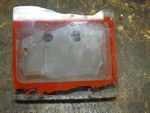 Front |
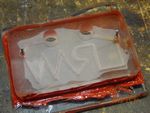 Back - note PCB pins for electrodes |
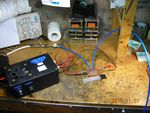 Gas inlet on left (with needle valve), vacuum on right |
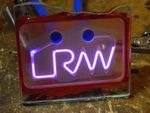 In operation |
The acrylic itself didn't seem affected significantly by the discharge, except around the cathode terminal where burning/charring was clearly visible. (The cathode will always heat up more because of the ion bombardment.)
Next, I went for the full-blown streetmap. I took a map of central Edinburgh and traced out the main streets to mark where the channels should go. Here's the original map and my traced channels:
 Original map |
 Traced channels |
The gas and vacuum connections are the large circles at the left and right. I joined up the ends of the streets so there is a continuous path right around the city center - this will allow the gas to reach all of the channels. Electrodes are placed at Charlotte Square, The Usher Hall, The Royal Museum, Waverley station, and St. James' shopping center. The overall dimensions of the device are 9x5cm.
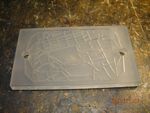 |
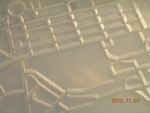 |
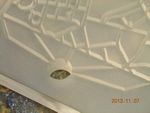 |
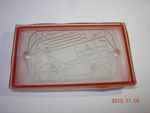 |
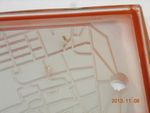 |
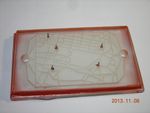 |
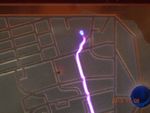 |
It worked very well! Here's photos of the discharges between all possible electrode combinations:
For some of the paths, there seemed to be two routes which were equally preferred, but the discharge settled down into one after a few seconds. I checked with the directions given on Google Maps, and they do actually match up pretty well (obviously I'm giving equal "weight" to each street, but Google seems to handle pedestrian/vehicle routes differently). Even if it isn't exact, it's still a neat demonstration.
Lastly, here's a video of everything in operation.
| ▲ Vacuum |